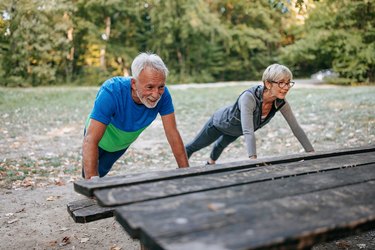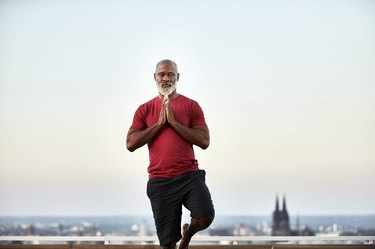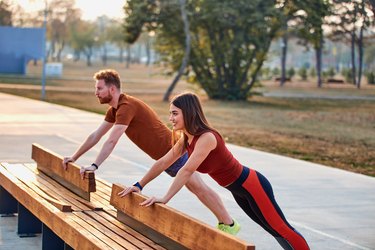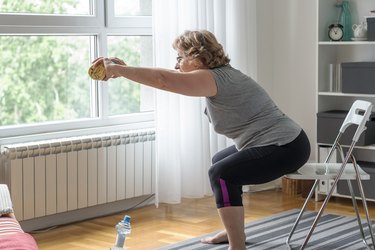

As we age, balance is essential for preventing falls and carrying out everyday tasks — and core training is the foundation of building balance and strength. A strong core helps protect our spine and allows us to bend, rotate, carry, sit down and stand back up.
"If you look at a skeleton, you'll notice that there is truly no larger supportive structure that separates the rib cage and the pelvis. It is simply that spine that connects the two. What supports and stabilizes the body between our upper and lower extremities is the core," says Tina Tang, CPT, a New Jersey–based personal trainer who specializes in healthy aging. "A strong core supports and stabilizes all movement."
Video of the Day
Fortunately, there are many great core-strengthening exercises for older adults that mimic movements you do every day so you can remain strong in those movement patterns as you age.
How Do I Strengthen My Core Over 50?
The best core exercises for seniors are those that involve rotation and anti-rotation, Tang says. For example, a Paloff twist involves rotating your body while purposefully engaging your core to support your body. On the other hand, a Paloff hold is an anti-rotation exercise because you're using your core to stabilize you and resist the pull of the resistance band. (Combining the two is a great addition to your workout routine if you're aiming for a flat stomach over 50).
So, how often should older adults train their core? Tang recommends three times a week, and there isn't a fast way to strengthen your core. It's a matter of doing these exercises consistently.
Ahead, Tang shares the best core-strengthening exercises for older adults. These exercises target every facet of your core, including your rectus abdominis, transverse abdominis, obliques, as well as your hips and lower back.
When incorporating these core exercises into your workout routine, Tang recommends choosing three moves from the list below and doing them as a circuit.
For example, you can do the Paloff hold, bent-knee side plank and the Paloff twist; or the dead bug, Paloff hold and the side bend. Or, swap in some of the exercises for the moves in this 20-minute core workout for older adults.
1. Dead Bug
The dead bug is one of the most accessible core exercises for beginners over 50 because you're lying on your back, Tang says. "If you have cranky knees or hips, this exercise allows you to lie on the ground."
- Begin on your back with your legs in a tabletop position, knees bent to 90 degrees and your hands on your knees.
- Bracing your core, extend your right leg out in front of you and your right arm overhead. Keep your left hand on your left knee and your lower back anchored to the ground throughout the exercise.
- Hold this position for a second, then bring your right leg back to the starting position as your right arm reaches for the ceiling.
- Do 10 reps on your right side, then repeat on your left side.
Tip
Engage your core by filling the sides of your ribcage with air as you take a deep breath in. As you exhale, lift your pelvic floor muscles up and in while stiffening your lower abs.
"Every time you extend your arm or leg and have it hover over the ground, that's when your back wants to lift up from the ground. But if you press your core down into the ground and engage it as you move your body, your back will feel supported," Tang says.
2. Heel Tap
For those who have shoulder issues and aren't able to extend their arms overhead in a dead bug, heel taps are a great floor exercise alternative. "This way you can just focus on tapping your feet down while tightening your core," Tang says.
- Begin on your back with your legs in a tabletop position, knees bent to 90 degrees and your arms extended, reaching for the ceiling.
- Bracing your core and keeping your right knee bent, tap your right heel to the ground. Pin your back to the ground throughout the exercise and keep your arms reaching for the ceiling.
- Bring your right knee back to the starting position, then repeat with your left leg.
- Do 10 reps on each leg.
3. Bent-Knee Side Plank
This plank variation targets your obliques, aka your side abs, and is a regression of the regular side plank, which can be challenging for older adults as well as people who are just getting back into exercise. The bent knee provides a greater base of support.
- Lie on your right side with your left hip stacked over your right and bend your knees behind you to 90 degrees.
- Stacking your right shoulder over your elbow with your forearm flat on the ground, prop yourself on your forearm.
- Brace your core and tighten your glutes to lift your hips off the ground. Make sure to keep your hips square throughout the exercise. You can extend your left arm toward the ceiling or place your left hand on your left hip.
- Hold this position for 30 seconds, then lower back down and repeat on the left side.
Tip
Keep your feet directly behind your butt while your knees are bent to 90 degrees. "The tendency is to have your hips pushed back, but you want to have your tailbone tucked under," Tang says. She suggests imagining the way a dog will tuck their tail if they're scared.
4. Side Plank Twist
If you're looking to take your bent-knee side plank up a notch, try the side plank twist. In this side plank variation, you're staggering your feet to help give you a solid base of support. (Plank variations like this are a key addition in the best workout for men over 50.) As with the previous exercise, you want to keep your tailbone tucked as you twist down, Tang says.
- Lie on your right side with your left hip stacked over your right. Bring your top foot (your left foot) out in front of your body to help you stabilize.
- Stacking your right shoulder over your elbow with your forearm flat on the ground, prop yourself on your forearm.
- Brace your core and tighten your glutes to lift your hips off the ground. Extend your left arm toward the ceiling. Make sure to keep your hips square throughout the exercise.
- Rotate your torso toward the floor and thread your left arm underneath your body.
- Reverse the movement to return to the starting position.
- Do 10 reps, then switch sides.
5. March
Marches are one of the most functional core exercises you can do because they mimic many everyday movements, like standing up from a seated position or getting in and out of a bathtub, Tang says.
"This is a great exercise for testing your balance. You're trying to lift one knee up at a time. I like to tell people to visualize because you can feel as you're lifting you knee up, your hip flexor is working, but your core's really tightening to help you balance," she says.
- Stand with your feet hip-width apart and your arms by your sides.
- Using your core, lift your right knee up toward your chest, forming a 90-degree angle with your leg. At the same time, extend your left arm overhead.
- Slowly lower your right leg and left arm down to the starting position and alternate sides.
- Do 10 reps on each side.
Tip
If you're not able to balance on one leg at a time, you can do seated marches: Sit down on a chair with your feet flat on the floor, and with control, lift one leg up and lower it back down. Focusing on leg-strengthening exercises is another great way to improve lower-body balance.
6. Side Bend
This core exercise targets your obliques, which are responsible for side bending your torso. Your other ab muscles are also activated to stabilize you as you lower down and come back up, Tang says. Also highly functional, this move will help you feel strong when bending over to pick up something from the ground.
- Stand with your feet hip-width apart and your arms by your sides.
- Keeping your torso straight, bend to your right side from your waist.
- Return to the center. This is 1 rep.
- Bend sideways to the left, and continue to alternate.
- Do 10 reps on each side.
Tip
If you'd like to make this exercise a little more challenging, hold a light dumbbell in each hand. To regress the movement, you can do it seated.
"Before you bend, you want to lift your ribcage out and away from your pelvis, and then bend to really target your obliques," Tang says.
7. Incline Push-Up
With age, most people don't work their upper body nearly enough. The incline push-up strengthens your core, as well as your shoulders, back and chest. It's a great move for building the strength to do a regular push-up on the ground.
- Facing an exercise box or bench, place your hands flat on the surface with your shoulders over your wrists.
- Walk your feet back until your body is at a 45-degree angle.
- Tightening your glutes and quads and bracing your core, bend your elbows as you lower yourself as close to the box as possible. Remember to keep your spine straight.
- Press your palms into the box and push yourself back up to the starting position.
Tip
"Squeeze your heels and knees together and focus on the leg squeeze on the way down. It engages your core a lot more than when your feet are a little wider. Having your feet wider will give you a more stable base, but squeezing your legs will help you kick in your core," Tang says.
You can try placing a yoga block between your upper thighs to help you consciously squeeze your legs. How low should you go? Tang recommends aiming for a fist and half away from the surface.
If an incline push-up is too challenging for you right now, you can place your hands on a higher surface, like the kitchen counter, or do a wall push-up.
8. Paloff Hold
Tang likes the Paloff hold for an anti-rotation core exercise that works your obliques as you resist the pull of the resistance band.
"You want to keep your shoulders down and hold the band straight in front of you. You're activating your core to avoid letting the band pull you one way," she says.
- Loop a resistance band around a sturdy anchor. Stand with your right side facing the anchor and hold the band with both hands at your chest. Walk far away enough so that there's tension in the band. Situate your feet about shoulder-width apart with a slight bend in your knees.
- Keeping the rest of your body still, extend your arms out in front of you until your elbows are straight.
- Hold here for 30 seconds, then bring your hands back in to return to the starting position.
- Repeat on the left side and hold for 30 seconds.
Tip
Tang suggests using a medium resistance band to start. This will give you enough resistance but not too much that you can't do the exercise with good form. Remember to maintain an athletic stance with your knees slightly bent.
9. Paloff Twist
Unlike the hold in the previous exercise, the Paloff twist is a rotation exercise, which also activates your obliques as you turn away from the anchor point.
- Loop a resistance band around a sturdy anchor. Stand with your right side facing the anchor and hold the band with both hands at your chest. Walk far away enough so that there's tension in the band. Situate your feet about shoulder-width apart with a slight bend in your knees.
- Keeping the rest of your body still, extend your arms out in front of you until your elbows are straight.
- Pivot your feet as you turn your shoulders, chest and hips to the left.
- Return to the center and repeat for 10 reps, then switch sides.
Tip
"You want to pivot your feet so that your chest and hips are always moving in the same direction. When you turn, have your hips turn with your chest so that everything turns as one piece," Tang says.
What Are Signs of a Weak Core?
It's difficult to define what a "weak core" is because everyone has some level of core strength, Tang says.
"Anyone who is strength training will have a stronger core than someone who isn't exercising. The core is essential for all body movement and is especially active during strength-training exercises," she says.
That said, if you have a hard time standing up from a seated position and need to hold onto something for support, that's a sign that you may have a weaker core, as well as weaker legs.


